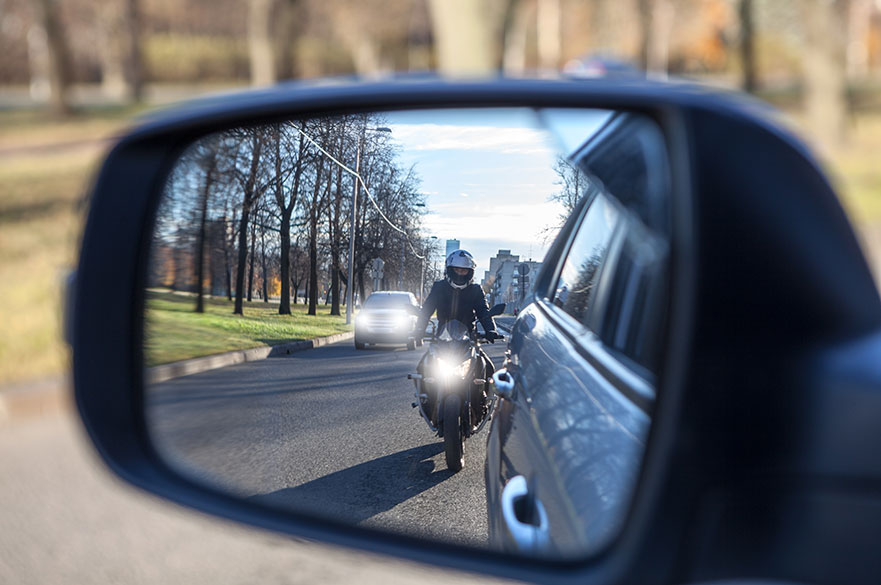Video tutorial shown to cut driver blind spots toward motorcyclists
New research which explores why car drivers often fail to spot motorcyclists on the road has revealed how a simple video intervention could help save lives – with 92% of drivers reporting a greater understanding of hazards.
By Helen Breese | Published on 10 July 2025
Categories: Press office; Research; School of Social Sciences;

Despite making up less than 1% of UK road traffic, motorcyclists account for nearly 20% of road fatalities.
The Motorcycles in the Mind’s Eye study by psychologists at Nottingham Trent University, funded by the Road Safety Trust, explores the theory that many of these incidents are not due to carelessness, but to a lack of experience and flawed ‘mental models’ whereby car drivers and motorcyclists think differently about road situations.
Motorcycles, due to their smaller size, relative rarity, and distinct road behaviour, are significantly harder for drivers to detect, particularly in less predictable scenarios such as overtaking stationary traffic.
Many motorists lack sufficient exposure to motorcycles, making it difficult to form reliable mental models of where and how they might appear. This often leads to “Look But Fail To See” errors, where a driver may glance directly at a motorcyclist yet fail to register them as a potential hazard. Even when noticed, accurately judging the speed of an oncoming motorcycle remains a common challenge for drivers.
“Drivers aren’t ignoring motorcyclists, they often just don’t expect them to be there,” said Professor David Crundall, lead researcher and Professor of Psychology at NTU’s School of Social Sciences. “Our brains are wired to look for what we’re used to seeing, and for most drivers, that doesn’t include motorcycles.”
"Look But Fail To See"
The research team used virtual reality and eye-tracking technology to compare how car drivers and dual drivers - those who also ride motorcycles - responded to road hazards. In one key scenario, dual drivers were significantly faster at spotting a motorcycle overtaking stationary traffic, highlighting how experience shapes awareness.
The participants were then shown short educational videos explaining the psychological reasons behind these “Look But Fail To See” errors.
Among the 71 car drivers who viewed the video, 92% reported a greater understanding of the causes behind car-motorcycle collisions. Additionally, 88% indicated they were likely to adjust their driving behaviour as a result, and the same percentage expressed increased empathy toward the challenges motorcyclists face on the road.
Motorcyclists also reacted positively to the intervention. After watching the video, 91% of 78 viewers said their awareness of the causes of collisions with cars had improved. Meanwhile, 85% stated they would modify their riding behaviour accordingly, and 65% felt more empathetic toward the difficulties encountered by car drivers.
However, the biggest impact was seen in car drivers, who became more aware of their own limitations and more cautious in high-risk situations.
The study also highlights how car drivers and motorcyclists often see each other as “outsiders,” leading to negative stereotypes and reduced empathy on the road. This can cause both groups to misjudge each other’s actions, increasing the risk of collisions.
By explaining the psychological reasons behind these biases - such as how drivers may genuinely fail to see motorcycles due to limited experience - the research aims to foster understanding and improve safety.
Ruth Purdie OBE, CEO of The Road Safety Trust, said: “This has been a genuinely fascinating study into the psychology of motorists and motorcyclists which is providing some incredibly useful insight into the respective hazard perceptions of both road user groups.
“The videos which have been produced as a result are really thought-provoking. Those who have viewed them are reflecting on their driving standards and hazard awareness – and that can only have a positive impact in helping to save lives on our roads.”
The researchers are now calling for these videos to be included in driver training and road safety campaigns across the UK.
Notes for Editors
Press enquiries please contact Helen Breese, Public Relations Manager, on telephone +44 (0)115 848 8751, or via email.
About Nottingham Trent University
Nottingham Trent University (NTU) has been named UK ‘University of the Year’ five times in six years, (Times Higher Education Awards 2017, The Guardian University Awards 2019, The Times and Sunday Times 2018 and 2023, Whatuni Student Choice Awards 2023) and is consistently one of the top performing modern universities in the UK.
It is the 3rd best modern university in the UK (The Times and Sunday Times Good University Guide 2023). Students have voted NTU 1st in the UK for student employability (Uni Compare 2025)
NTU is the 5th largest UK institution by student numbers, with over 40,000 students and more than 4,400 staff located across six campuses. It has an international student population of almost 7,000 and an NTU community representing over 160 countries.
NTU owns two Queen’s Anniversary Prizes for outstanding achievements in research (2015, 2021). The first recognises NTU’s research on the safety and security of global citizens. The second was awarded for research in science, engineering, arts and humanities to investigate and restore cultural objects, buildings and heritage. The Research Excellence Framework (2021) classed 83% of NTU’s research activity as either world-leading or internationally excellent.
NTU was awarded GOLD in the national 2023 Teaching Excellence Framework (TEF) assessment, as it was in 2019.
NTU is a top 10 for sport (British Universities and Colleges Sport league table 2023).
NTU is the most environmentally sustainable university in the UK and second in the world (UI Green Metric University World Rankings, 2023).